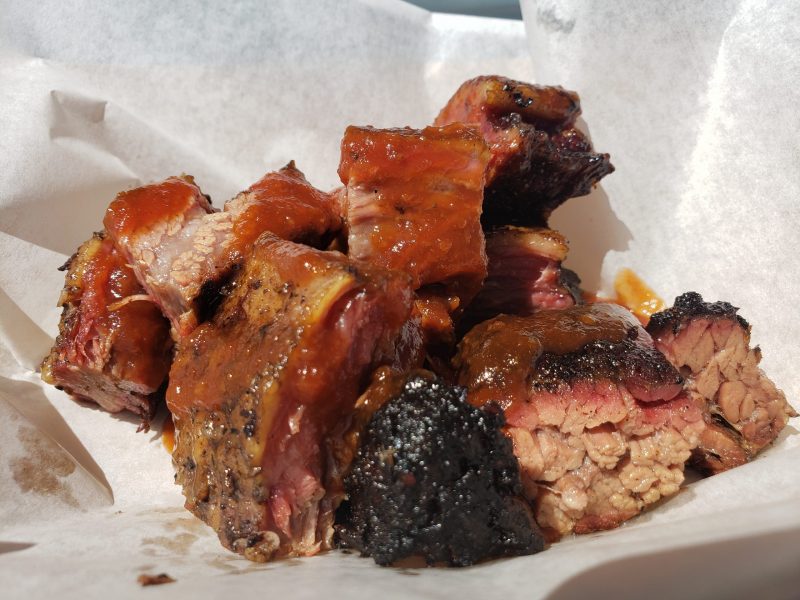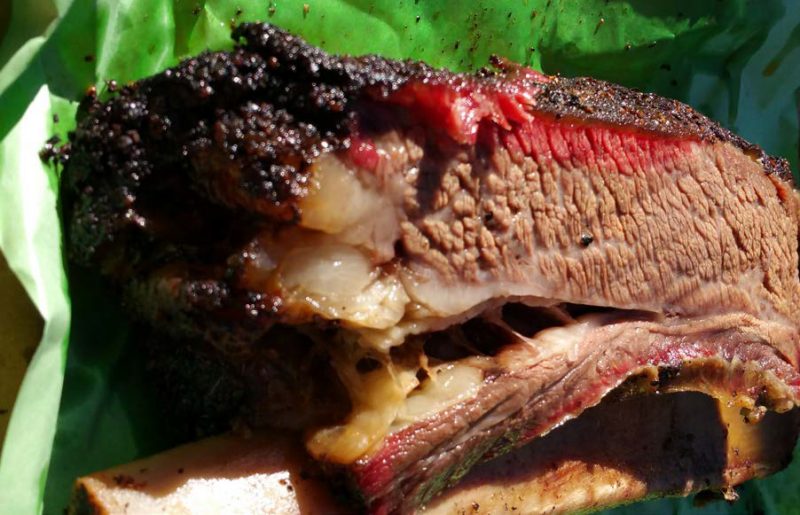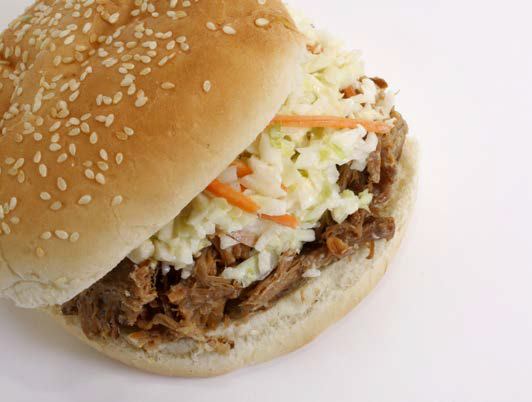This article originally appeared in the Winter 2021/2022 print issue of Quench Magazine.
Barbecue brings together a fun mix of food, folklore and fussing.
Meat-loving Americans eagerly argue about what true barbecue is and where to find the best version of it. As timeless as these food fights seem, the notion that barbecue has a terroir is little more than a hundred years old. At the turn of the twentieth century, barbecue transitioned from whole animal cooking in rural areas to cooking smaller cuts of meat in urban centers. As barbecue historian Robert F. Moss observed, this culinary shift sparked a period of innovation that gave rise to multiple barbecue styles that placed an emphasis on certain meats, sauces, and side dishes. Here’s a helpful field guide to its regional barbecue styles:
Virginia
Though barbecue’s early history is hazy, this southern state is generally recognized as American barbecue’s birthplace. It was here that Native American, European colonizers, and enslaved Africans melded their meat cooking techniques to create barbecue. Free and enslaved Virginians were primarily responsible for spreading barbecue across the American South. Whole animal cooking predominated, and beef, lamb, pork, or wild game could show up over the pit. Curiously, Virginians didn’t fervently promote their birthright, and now other states get much more barbecue love.
North Carolina
When it comes to barbecue, this state is split in two on the topic of barbecuing pork. In the eastern part of the state, cooking whole hogs seasoned with a vinegar and red pepper sauce is the longstanding tradition. This barbecue is served by chopping up and mixing everything, including the crispy skin. By the 1920s, in the western part of the state, German immigrants started a new style by barbecuing pork shoulders and saucing them with a vinegary tomato sauce. This is also known as “Lexington-style” barbecue. Favored side dishes are coleslaw and “hush puppies” (a cornmeal fritter).
South Carolina
This state’s barbecue tradition shares much in common with Virginia and North Carolina. Pork is the go-to meat here and it can be either chopped or whole. Barbecue diners in different parts of the state show allegiance to either a vinegar and red pepper, mustard-based, or tomato-based barbecue sauce. An interesting side dish served here is “barbecue hash,” where meat and/or organs (usually pork liver) are ground, cooked in a gravy, and served over rice.
Deep South
This region mainly includes Alabama, Georgia, and Mississippi. It’s an area where pork shoulder, pork spareribs, and chicken usually play a starring role and are served with a slightly sweet, vinegar and tomato-based sauce that tends to be thin. Soulful beverages, side dishes, and desserts like syrupy sweet tea, cornbread, greens, macaroni and cheese, pickles, peach cobbler, potato salad, and sliced white bread are accompaniments. In Georgia, barbecue often comes with Brunswick stew–a medley of chicken pieces, tomatoes, and assorted vegetables that descends from a hunter’s stew made with wild game.
Memphis, Tennessee
This is barbecue’s version of “Funky Town,” where anything can happen on a barbecue plate. The city has two signature barbecue items: pork spareribs and a pork shoulder sandwich topped with coleslaw. Even spareribs are divided into categories, mainly based on the way they are seasoned. “Dry ribs” were created at The Rendezvous restaurant, where slabs of pork spareribs are smothered with a Greek herb seasoning. “Wet ribs” means that the slab has been slathered with a thin, sweet, tomato sauce. Memphis is one of the few places where one finds a tangy mustard slaw on the menu, as well as unusual specialties like barbecued bologna and barbecued spaghetti, where barbecue sauce is substituted for marinara and mixed with grilled meat.
Kentucky
Lamb, specifically mutton, gets top billing in this state. The focal point is Owensboro where mutton is often paired with a Worcestershire sauce-based condiment called “black dip.” In other parts of the Bluegrass State, beef, chicken, ham, and pork steaks are on barbecue restaurant menus. One distinctive side dish is a thick meat (typically chicken and lamb) and vegetable stew called “burgoo,” another descendent of a hunter’s stew.
The South Side, Chicago, Illinois
During “The Great Migration,” thousands of African Americans left the rural South and moved to Chicago. Over time, a majority settled in the southern and western parts of the city. It’s the South Side that stamps its name on this regional style featuring pork sparerib tips, hot link sausages, French fries, fried chicken, and sliced white bread. When served, this barbecue is often drenched in a thin, sweet tomato-based barbecue sauce.
Kansas City, Missouri
One of the nation’s great agricultural centers is home to a thriving, but eclectic, barbecue style. Beef, “burnt ends” (crispy shards of beef brisket), chicken, lamb, mutton, pork shoulder (either chopped or sliced), or pork spareribs are popular menu items. The typical side dishes are baked beans, coleslaw, a mound of French fries, and sliced white bread served with a thick, sweet, tomato-based sauce.

Beef rib from Micklethwait Craft Meats in Austin TX 
Pulled-pork barbeque sandwich with cole slaw.
St. Louis, Missouri
This city shares much in common with Kansas City, but it has some unusual items. One is turkey “ribs” where a turkey’s shoulder blades are butchered in a way where enough meat is left so that it resembles a baby back rib. Another is “snoots,” which is the very end of a pig’s snout. It’s usually crispy and might be slathered with the sweet, tomato-based barbecue sauce also found in Kansas City.
East Texas
Enslaved African Americans brought old-school barbecue here in the early decades of the nineteenth century. In addition to whole animal cooking, including goats, you’ll find beef brisket, pork spareribs, and sausage. Given the proximity to Louisiana, Creole-based foods accompany barbecue in this part of the state. Typical options are boudain (an unusual spelling variant from boudin), a meat and rice-filled sausage or a highly seasoned, as well as an uncased, meat and rice mixture called “dirty rice.”
Central Texas
Central European immigrants brought their indirect smoking techniques to this area in the 1800s. They opened meat markets and smoked unsold cuts to feed nearby workers during lunchtime. Beef brisket, pork spareribs, and a finely ground sausage called “hot guts” are very popular and served with a chunk of cheddar cheese, coleslaw, jalapeno peppers, pinto beans, potato salad, and saltine crackers. For a sense of nostalgia, barbecue is served to customers on butcher paper.
South Texas
Long before Texas was a country or a state, Latinos barbecued by digging a deep vertical hole in the ground, filling the bottom with a combination of burning hardwood coals and rocks to retain the heat. Traditionally, the hole was alternately layered with moist vegetation and meat, buried with dirt, and then uncovered hours later when people were ready to eat. Today, the same is accomplished by digging the hole but using metal containers and sheet metal as a cover. A cow’s head, known as “cabeza,” or a young goat, called “cabrito,” are prepared this way.
Santa Maria, California
This is a unique barbecue tradition featuring beef tri-tip seasoned with garlic, salt, and pepper, then cooked over red oak wood and served with pinquitos, a small pink bean native to the area, a salad, and salsa.
Now, you’re all set for your smoked meat safari in the United States. If you do ever get into an argument about which regional style is the best, just remember not to yell with your mouth full of delicious barbecue!

Click here for the recipes for Old Arthur’s Pork Belly Burnt Ends and Ed Mitchell’s Mother’s Whole Turkey Barbecue
Adrian Miller is a food writer and recovering attorney who lives in Denver, Colorado. He served as a special assistant to President Bill Clinton with his Initiative for One America – the first free-standing office in the White House to address issues of racial, religious and ethnic reconciliation. Adrian’s first book, Soul Food: The Surprising Story of an American Cuisine, One Plate at a Time won the James Beard Foundation Award for Scholarship and Reference in 2014. His most recent book, Black Smoke: African Americans and the United States of Barbecue, was published in 2021 and won the 2022 James Beard Award for the same category. Adrian is featured in the Netflix series High on the Hog: How African American Cuisine Transformed America.
Feature Photo: Kansas City burnt ends | Photo credit: supplied


